#ancientchristianity
Explore tagged Tumblr posts
Text
youtube
#Orthodoxy#EasternOrthodox#OrthodoxChristianity#GreatLent#Lent#OrthodoxLiturgy#JesusChrist#OrthodoxFaith#Christianity#OrthodoxPrayer#OrthodoxChant#ByzantineChant#MonasticChant#Repentance#HolyTradition#ChristianMysticism#SyriacChristianity#SyriacOrthodox#Aramaic#ChurchOfTheEast#AssyrianChurch#ChaldeanChurch#OrientalOrthodox#AncientChristianity#SyriacHymns#Maronite#SaintEphrem#HolyFathers#TrueOrthodoxy#TradOrthodox
1 note
·
View note
Text
On the eve of Lent…
2 notes
·
View notes
Photo
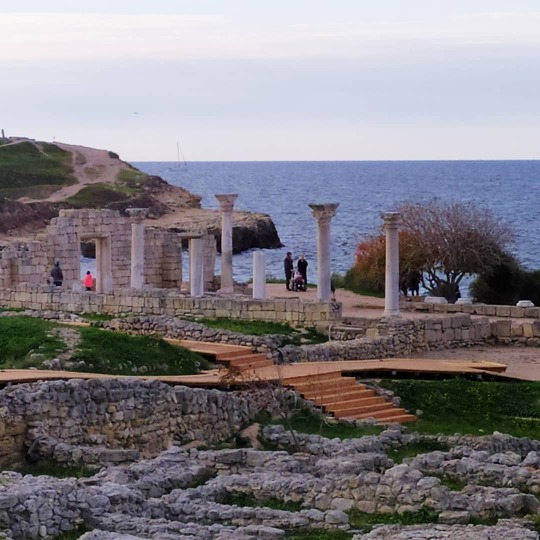
"Базилика 1935 г." (VI - X вв.), один из главных символов древнего города Херсонес Таврический. Посвящение храма неизвестно, поэтому он назван по году его открытия археологами. Колонны этой христианской церкви, запечатленные фотографами на фоне моря или голубого неба, часто призваны были создавать античный колорит. Стены храма покрывали фрески, реконструкции которых выставлены в Средневековом разделе Музея. Учеными высказывается, предположение о существовании в позднеантичный период на месте Базилики 1935 г. иудейского молитвенного дома - синагоги. / "1935 Basilica " (6 - 10 centuries), one of the main symbols of the ancient city of Tauric Chersonesos. The dedication of the temple is unknown, so it is named after the year of its discovery by archaeologists. The columns of this Christian church, captured by photographers against the background of the sea or blue sky, were often designed to create an antique flavor. The walls of the temple were covered with frescoes, reconstructions of which are exhibited in the Medieval section of the Museum. Scientists suggest the existence of a Jewish prayer house - a synagogue in the late antique period on the site of the 1935 Basilica. #Херсонес #СеверноеПричерноморье #Античность #ДревняяГреция #ДревнийРим #ПоздняяАнтичность #древнийгород #раннееХристианство #греки #Chersonesos #NorthBlackSeaCoast #Antiquity #AncientChristianity #AncientRome #LateAntiquity #AncientCity #Greece # ByzantineArt #daand_photo #daand_art #севастополь #Крым #историяКрыма #древнийМир #ГреческиеКолонии #Crimea #Bizance #Византия #базилика #археология #базилика1935 (at Севастополь, Крым) https://www.instagram.com/p/CISIG__JV59/?igshid=17n1qmt90kk8q
#херсонес#с��верноепричерноморье#античность#древняягреция#древнийрим#поздняяантичность#древнийгород#раннеехристианство#греки#chersonesos#northblackseacoast#antiquity#ancientchristianity#ancientrome#lateantiquity#ancientcity#greece#daand_photo#daand_art#севастополь#крым#историякрыма#древниймир#греческиеколонии#crimea#bizance#византия#базилика#археология#базилика1935
0 notes
Photo
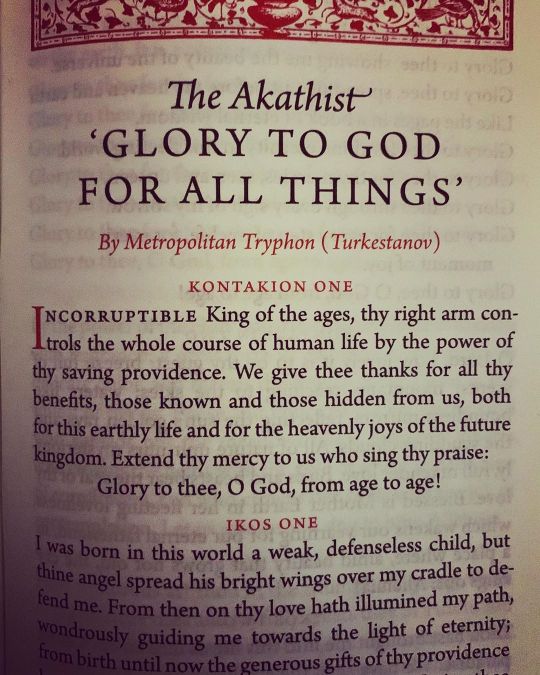
Glory to thee, treating pain and loss with the healing passage of time. Glory to thee, with whom there is no grief without hope, O Giver of life to all. Glory to thee, who hast made immortal all that is lofty and good and who dost promise us that longed-for meeting with those who have died. Glory to thee, O God, from age to age! #GloryToGodForAllThings #prayer #Christian #ancientchristianity #hope #love https://www.instagram.com/p/B97JUQTnURi/?igshid=k43ipafymok0
0 notes
Text
WISDOM!!

Your life on earth is narrowed everywhere. Everything betrays you: relatives, friends, acquaintances, wealth, the pleasures of the senses, your own body will at some point abandon you.
All the elements of nature deceive you.
So, see to cleave only to God, for only He is love.
Saint John of Krostandt
92 notes
·
View notes
Text
Join me in taking Hillsdale’s free online course, "Ancient Christianity": https://online.hillsdale.edu/landing/ancient-christianity?utm_source=housefile&utm_medium=referral&utm_campaign=ancientchristianity
5 notes
·
View notes
Photo

Sciences and artistry that attempt to capture the esotericism of Christmas yield nothing but banalities and platitudes only found in the unfortunate commercialism culture has produced. Such human reasoning can never ask whether such exists as existence is beyond human reasoning. #christmastree #christmas #hermeticism #study #revolt #neotraditionalist #higherconsciousness #traditionalist #unlock #secretsoftheuniverse #unmovable #God #arithmetic #icon #calvinist #catholic #ancientchristianity #mystical #begininngless # (at Oregon) https://www.instagram.com/p/BrszPmrAOjv/?utm_source=ig_tumblr_share&igshid=5027r9c3xmnk
#christmastree#christmas#hermeticism#study#revolt#neotraditionalist#higherconsciousness#traditionalist#unlock#secretsoftheuniverse#unmovable#god#arithmetic#icon#calvinist#catholic#ancientchristianity#mystical#begininngless
0 notes
Photo
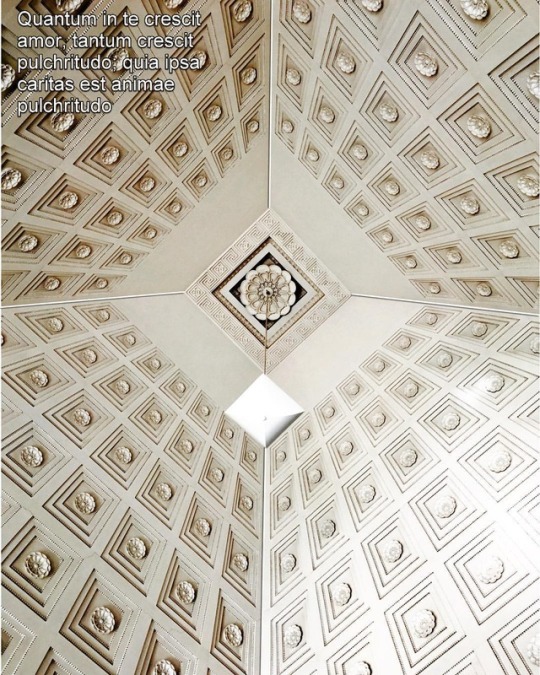
Ceiling inside the step pyramid of the southern wing of #NyCarlsbergGlyptotek in #Copenhagen --------------------- Quantum in te crescit amor, tantum crescit pulchritudo; quia ipsa caritas est animae pulchritudo (Sanctus Augustinus, epistulam Ioannis ad Parthos, tractatus IX, 9) Soviel in dir die Liebe wächst, soviel wächst die Schönheit in dir. Denn die Liebe ist die Schönheit der Seele. (Augustinus von Hippo) Beauty grows in you to the extent that love grows, because charity itself is the soul's beauty. (Augustine of Hippo) #augustineofhippo #sanctusaugustinus #churchfathers #catholictheologian #ancientchristianity #glyptoteket #glyptoteketcopenhagen #nycarlsbergglyptotek #classicalarchitecture #ceilings #stucco (her: Glyptoteket)
#churchfathers#ancientchristianity#stucco#glyptoteket#ceilings#classicalarchitecture#sanctusaugustinus#glyptoteketcopenhagen#catholictheologian#nycarlsbergglyptotek#copenhagen#augustineofhippo
0 notes
Text
Myrrhbearer and Equal of the Apostles Mary Magdalene
The Holy Myrrh-Bearer Equal of the Apostles Mary Magdalene. On the banks of Lake Genesareth (Galilee), between the cities of Capharnum and Tiberias, was the small city of Magdala, the remains of which have survived to our day. Now only the small village of Mejhdel stands on the site.
A woman whose name has entered forever into the Gospel account was born and grew up in Magdala. The Gospel tells us nothing of Mary’s younger years, but Tradition informs us that Mary of Magdala was young and pretty, and led a sinful life. It says in the Gospels that the Lord expelled seven devils from Mary (Luke. 8:2). From the moment of her healing Mary led a new life, and became a true disciple of the Savior.
The Gospel relates that Mary followed after the Lord, when He went with the Apostles through the cities and villages of Judea and Galilee preaching about the Kingdom of God. Together with the pious women Joanna, wife of Choza (steward of Herod), Susanna and others, she served Him from her own possessions (Luke 8:1-3) and undoubtedly shared with the Apostles the evangelic tasks in common with the other women. The Evangelist Luke, evidently, has her in view together with the other women, stating that at the moment of the Procession of Christ onto Golgotha, when after the Scourging He took on Himself the heavy Cross, collapsing under its weight, the women followed after Him weeping and wailing, but He consoled them. The Gospel relates that Mary Magdalene was present on Golgotha at the moment of the Lord’s Crucifixion. While all the disciples of the Savior ran away, she remained fearlessly at the Cross together with the Mother of God and the Apostle John.
The Evangelists also list among those standing at the Cross the mother of the Apostle James, and Salome, and other women followers of the Lord from Galilee, but all mention Mary Magdalene first. Saint John, in addition to the Mother of God, names only her and Mary Cleopas. This indicates how much she stood out from all the women who gathered around the Lord.
She was faithful to Him not only in the days of His Glory, but also at the moment of His extreme humiliation and insult. As the Evangelist Matthew relates, she was present at the Burial of the Lord. Before her eyes Joseph and Nicodemus went out to the tomb with His lifeless Body. She watched as they covered over the entrance to the cave with a large stone, entombing the Source of Life.
Faithful to the Law in which she was raised, Mary together with the other women spent following day at rest, because it was the great day of the Sabbath, coinciding with the Feast of Passover. But all the rest of the peaceful day the women gathered spices to go to the Grave of the Lord at dawn on Sunday and anoint His Body according to the custom of the Jews...keep reading source Orthodox Church of America
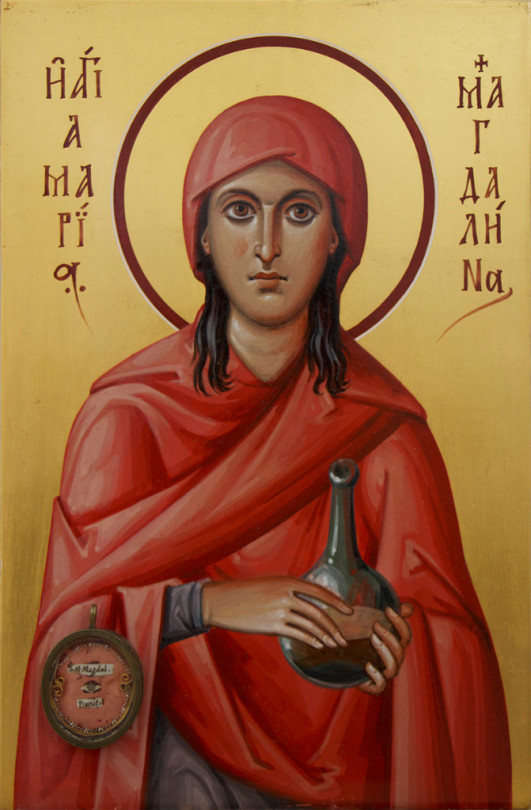
María estuvo al pié de la cruz donde murió su maestro, en el monte Calvario, mientras sus hombres lo han abandonado. Allí estaba Magdalena, acompañando a la otra María, la madre del crucificado."Junto a la cruz de Jesús estaban su madre y la hermana de su madre, María, mujer de Clopás, y María Magdalena", escribe el evangelista Juan (19:25). Y esta otra versión, por si caben dudas: "Había allí muchas mujeres mirando desde lejos, aquellas que habían seguido a Jesús desde Galilea para servirle. Entre ellas estaban María Magdalena, María la madre de Santiago y de José, y la madre de los hijos de Zebedeo" (evangelista Mateo 27:55-56). Más. “Después que José de Arimatea entierra a Jesús y se fue, María Magdalena quiso quedarse. Estaban allí María Magdalena y la otra María, sentadas frente al sepulcro" (Mateo 27:61).
3 notes
·
View notes
Video
youtube
Commentary on the Apocalypse of the Blessed John | St. Victorinus of Pettau | Christianity - Commentary | Audiobook full unabridged | English Content of the video and Sections beginning time (clickable) - Chapters of the audiobook: please see First comments under this video. This commentary is said to have been composed around 260, making it the earliest surviving commentary on Revelation. The author, St. Victorinus of Pettau (d. 303) flourished about 270, and was martyred during the Roman persecutions under Emperor Diocletian. The commentary does not cover every verse but focuses instead on key passages, giving mostly allegorical interpretations. He saw the Apocalypse as consisting of various subdivisions which run parallel with each other, the main theme of which is the coming Second Advent. - Summary by ancientchristian This is a Librivox recording. If you want to volunteer please visit https://librivox.org/ by Priceless Audiobooks
0 notes
Text
Saints&Reading: Tue., Apr., 13, 2021
March 31/April 13
Saint Innocent (Innokentii) (Veniaminov), Metropolitan of Moscow and Kolomensk (1879)

Saint Innocent Veniaminov Equal to the Apostles and Evangelizer of North America John Evseyevich Popov-Veniaminov was born August 8, 1797 in the village of Anginsoye in Irkutsk, Russia. His baptism took place in the local church [1]. His father was a church server, so it was natural that John began reading the Epistle during services at an early age [2]. When John was only six years old, his father died. Four years later, John entered the Irkutsk Theological Seminary. In 1817, he married, was ordained to the diaconate, and was assigned to serve at the Annunciation Church in Irkutsk. After his ordination to the priesthood in 1821, he taught catechism to children while serving the parish as its priest [3]. In 1823, Father John embarked on a great adventure. The Bishop of Irkutsk had been instructed to send a priest to Unalaska in Alaska’s Aleutian Islands. The clergy all refused to go – all, that is, except Father John. In May 1823, he and his wife, their infant son Innocent, and his mother and brother Stefan began the perilous journey. Fourteen months later they arrived on Unalaska Island [4] where he and his family lived in an earthen hut they had constructed themselves. A multi-talented man, he trained a group of local faithful in construction techniques and helped them build Holy Ascension Church, which they completed in 1826 [5]. Father John made numerous missionary journeys around Unalaska and the neighboring Fox and Pribilof Islands. He frequently traveled by dogsled or canoe, his tiny craft buffeted by storms in the Gulf of Alaska [6]. In 1834, he was transferred to New Archangel, later renamed Sitka, where he dedicated himself to ministering to the Tlingits. He studied their language and customs and produced scholarly notes and a dictionary. Among his other journeys was that he undertook in 1836, when he visited Fort Ross north of San Francisco and northern California’s Spanish missions. In 1838, Father John returned to Russia to report on his missionary efforts. While there, he received the sad news that his wife had died. After some time, he decided to enter monastic orders with the name Innocent, in honor of the sainted missionary Bishop of Irkutsk. Two years later, he was consecrated Bishop of Kamchatka and the Kurile Islands and the Aleutian Islands at the Cathedral of the Kazan Icon of the Mother of God in Saint Petersburg [7]. After his return to Alaska as the first resident Bishop in America, Bishop Innocent continued his missionary journeys, during which he proclaimed the Gospel in ways the people could easily understand and remember [8]. During one of his missionary journeys, Bishop Innocent encountered dangerously rough waters off Kodiak Island. Turning in the direction of Spruce Island, where Saint Herman of Alaska lived and was buried, he fervently entreated Saint Herman pray to God for assistance. Within minutes, the waters became calm [9]. His ongoing travels helped him to master local languages and dialects. He also developed alphabets for previously unwritten languages and translated Scripture and other works into Unagan and Yakut [10]. In 1848, Bishop Innocent had the joy of consecrating Saint Michael Cathedral in Sitka, which he used his talents to design and build [11]. The cathedral still serves as the main cathedral for the Diocese of Alaska. In recognition of his exceptional ministry, he was elevated to the dignity of Archbishop in 1850. Archbishop Innocent was elected Metropolitan of Moscow and Kolomna in 1868 [12]. As Metropolitan, he worked diligently to uplift the faithful spiritually and improve the living conditions of the clergy. He fell asleep in the Lord on March 31, 1879 and was buried in the Church of the Holy Spirit at the Trinity-Saint Sergius Lavra in Sergeiv Posad, near Moscow [13]. He was canonized in 1977 by the Church of Russia during the tenure of Patriarch Pimen of Moscow [14].
O Holy Father Innocent, pray to God for us! ■
Source: Orthodox Church of America
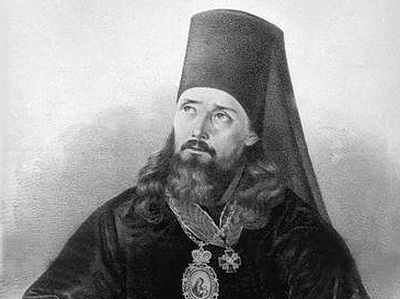
The Priest Martyr Ipatios, Bishop of Gangra,

The PriestMartyr Ipatios, Bishop of Gangra, was bishop of the city of Gangra in Paphlagonia (Asia Minor). In the year 325 he participated in the I OEcumenical Council at Nicea, at which the heresy of Arius was given anathema. When Saint Ipatios was returning in 326 from Constantinople to Gangra, followers of the schismatics Novatus and Felicissimus fell upon him in a desolate place. The heretics ran him through with swords and spears, and threw him from an high bank into a swamp. Like the First-martyr Arch-deacon Stephen, Saint Ipatios prayed for his murderers. A certain Arian woman struck the saint on the head with a stone, and he died. The murderers hid his body in a cave, where a christian who kept straw there found his body. Recognising the body of the bishop, he hastened to report about this in the city, and the inhabitants of Gangra piously buried the remains of their beloved arch-pastor. After death the relics of Saint Ipatios won reknown for numerous miracles, in particular the casting out of demons and for healing the sick.
From of old the Priestmartyr Ipatios was particularly venerated in the Russian land. Thus in the year 1330 was built at Kostroma the Ipatiev monastery, on the place of an appearance of the Mother of God with the Pre-eternal Christ-Child and saints that were present – the Apostle Philip and the Priestmartyr Ipatios, bishop of Gangra. This monastery afterwards occupied a significant place in the spiritual and social life of the nation, particularly during the years of the Time of Troubles. The old-time copies of the Vita of the Priestmartyr Ipatios were widely distributed in Russian literature, and one of these entered into the compiling of the Chet'i Minei [Reading Menaion] of Metropolitan Makarii (1542-1564). In this Vita was preserved an account about the appearance of the Saviour to Saint Ipatios on the eve of the martyr's death. The veneration to the saint consists of prayers, words of praise and teaching on the day of his memory. The pious veneration of Sainted Ipatios was also expressed in the liturgical works of Russian authors. During the XIX Century was written a new service to the Priestmartyr Ipatios, distinct from the services written by the Monk Joseph the Studite, contained in the March Menaion.
© 1996-2001 by translator Fr. S. Janos.
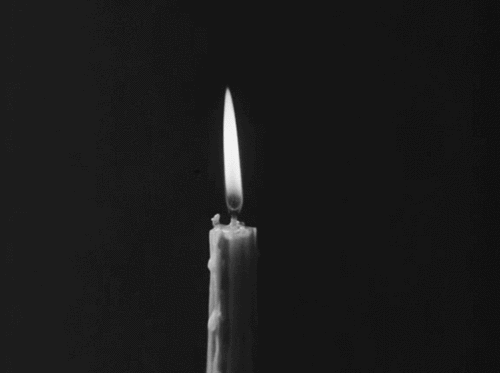

Isaiah 40:18-31
18 To whom then will you liken God? Or what likeness will you compare to Him?
19 The workman molds an image, The goldsmith overspreads it with gold, And the silversmith casts silver chains.
20 Whoever is too impoverished for such a contribution Chooses a tree that will not rot; He seeks for himself a skillful workman To prepare a carved image that will not totter.
21 Have you not known? Have you not heard? Has it not been told you from the beginning? Have you not understood from the foundations of the earth?
22 It is He who sits above the circle of the earth, And its inhabitants are like grasshoppers, Who stretches out the heavens like a curtain, And spreads them out like a tent to dwell in.
23 He brings the princes to nothing; He makes the judges of the earth useless.
24 Scarcely shall they be planted, Scarcely shall they be sown, Scarcely shall their stock take root in the earth, When He will also blow on them, And they will wither, And the whirlwind will take them away like stubble.
25 “To whom then will you liken Me, Or to whom shall I be equal?” says the Holy One.
26 Lift up your eyes on high, And see who has created these things, Who brings out their host by number; He calls them all by name, By the greatness of His might And the strength of His power; Not one is missing.
27 Why do you say, O Jacob, And speak, O Israel: “My way is hidden from the Lord, And my just claim is passed over by my God”?
28 Have you not known? Have you not heard? The everlasting God, the Lord, The Creator of the ends of the earth, Neither faints nor is weary. His understanding is unsearchable.
29 He gives power to the weak, And to those who have no might He increases strength.
30 Even the youths shall faint and be weary, And the young men shall utterly fall,
31 But those who wait on the Lord Shall renew their strength; They shall mount up with wings like eagles, They shall run and not be weary, They shall walk and not faint.
Proverbs 15:7-19
7The lips of the wise disperse knowledge, But the heart of the fool does not do so.
8 The sacrifice of the wicked is an abomination to the Lord, But the prayer of the upright is His delight.
9 The way of the wicked is an abomination to the Lord, But He loves him who follows righteousness.
10 Harsh discipline is for him who forsakes the way, And he who hates correction will die.
11 Hell and Destruction are before the Lord; So how much more the hearts of the sons of men.
12 A scoffer does not love one who corrects him, Nor will he go to the wise.
13 A merry heart makes a cheerful countenance, But by sorrow of the heart the spirit is broken.
14 The heart of him who has understanding seeks knowledge, But the mouth of fools feeds on foolishness.
15 All the days of the afflicted are evil, But he who is of a merry heart has a continual feast.
16 Better is a little with the fear of the Lord, Than great treasure with trouble.
17 Better is a dinner of herbs where love is, Than a fatted calf with hatred.
18 A wrathful man stirs up strife, But he who is slow to anger allays contention.
19 The way of the lazy man is like a hedge of thorns, But the way of the upright is a highway.
#orthodoxy#orthodoxchristian#ancientchristianity#originofchristianity#spirituality#sacred texts#oldtestament#prophets#wisdom
8 notes
·
View notes
Photo
Great in there you totally forgot about Jesus Christ, His example and His teaching of unconditional love. He is the ultimate redeemer. When he said Love your neighbor as yourself, did he made a distinction such as: love your neighbor except those....believing in Him is to trust Him not to substitute a hatred self to judge in HIs place. Spreading love, compassion and understanding is the only Christian Way, there’ s no other way. Only Him has the power to condemn or to redeem.
God blesses us all!!
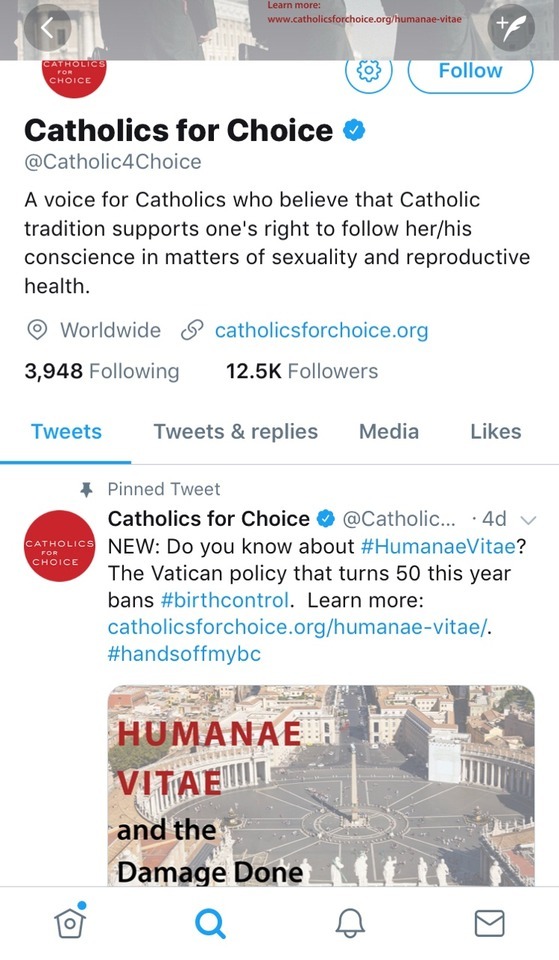
Heretics. You’re all heretics.
178 notes
·
View notes
Photo
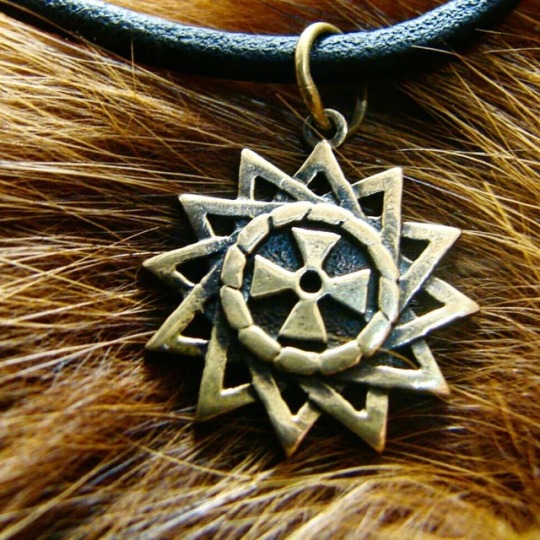
Thanks for the kind words! ★★★★★ "Das warten hat sich gelohnt. Gute Karma Anhänger . Danke " Jana #etsy #ukraenie #starnecklace #starjewelry #pendantertsgamma #talisman #christiannecklace #ertsgammajewelry #ancientchristian #artefaktum_ua #jewelry #giftforhim #giftforher #etsysale #gift #necklaces #pendant
#gift#ukraenie#ertsgammajewelry#starnecklace#talisman#etsy#ancientchristian#artefaktum_ua#necklaces#pendantertsgamma#pendant#jewelry#starjewelry#christiannecklace#etsysale#giftforher#giftforhim
0 notes
Photo
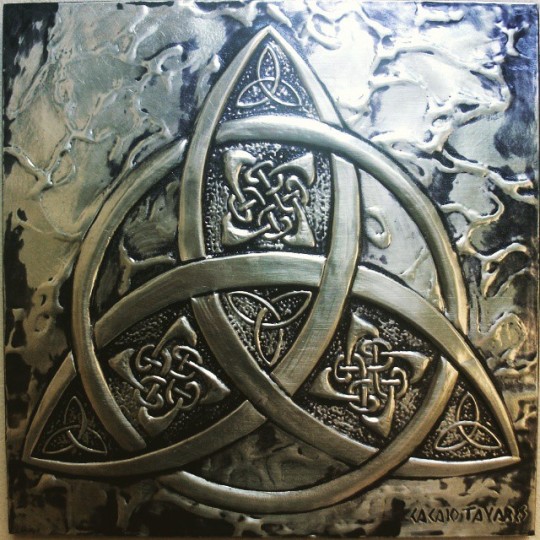
A Celtic prayer: I arise this day protected by the will of the Father. I arise this day assured by the blood of the Son. I arise this day revived by the life of the Spirit. I arise this day surrounded by the Company of the Father, Spirit, Son. Holy Trinity, Almighty Three-In-One. I arise this day. #prayer #Christian #ancientChristianity #Trinity
59 notes
·
View notes
Text
Icon, Saints&Reading: Tue., Apr., 27, 2021
April 14/27
Holy Apostles Aristarcus, Puden and Trophimus of the Seventy
All three are mentioned by name by the Apostle Paul. Aristarchus is mentioned in Acts 19:29, Colossians 4:10 and Philemon 24. He was bishop of Apamea in Syria; St Paul calls him 'my fellow-prisoner' and 'my fellow-laborer'. Pudens is mentioned in 2 Timothy 4:21. He was a prominent Roman citizen who gave refuge to Christians; his house was first a place of refuge for the Apostles, then one of the first churches in Rome. Trophimus is mentioned with Pudens in 2 Timothy 4:21, and in Acts 21:29, where we learn that he was from Ephesus. He accompanied the Apostle Paul on some of his missions. All three, like St Paul, were beheaded during Nero's persecutions.
Apostle Aristarchus of the seventy
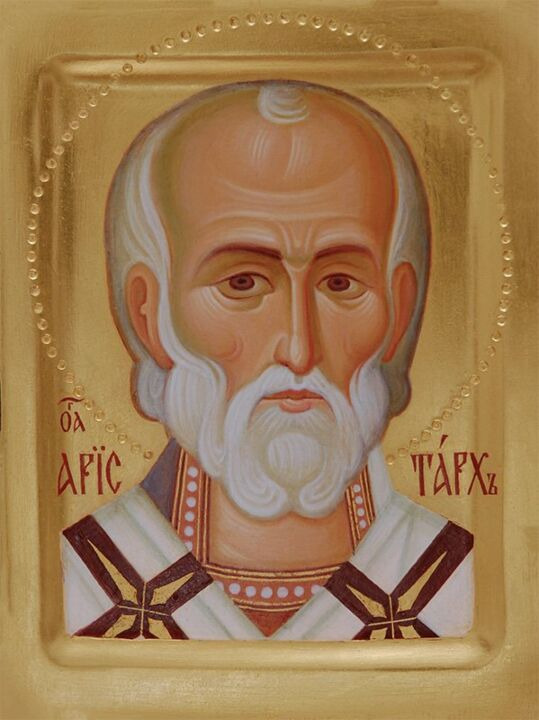
Apostle Trophimus of the seventy
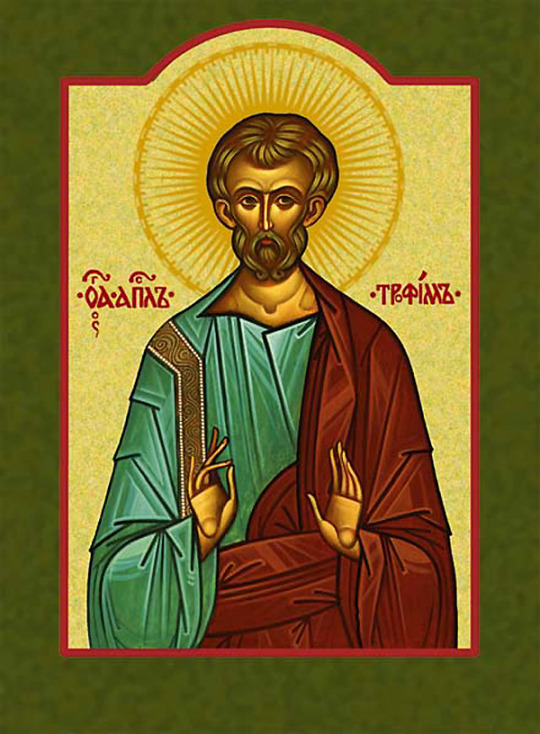
Apostles Aristarchus, Puden and Trophimus
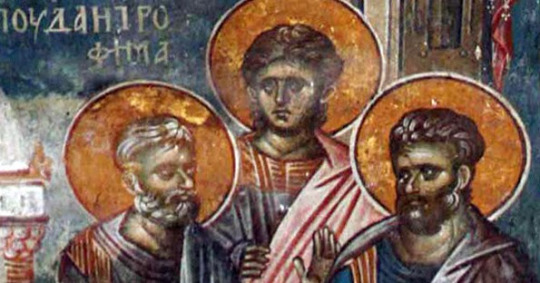
The Holy Martyr Ardalion (311)
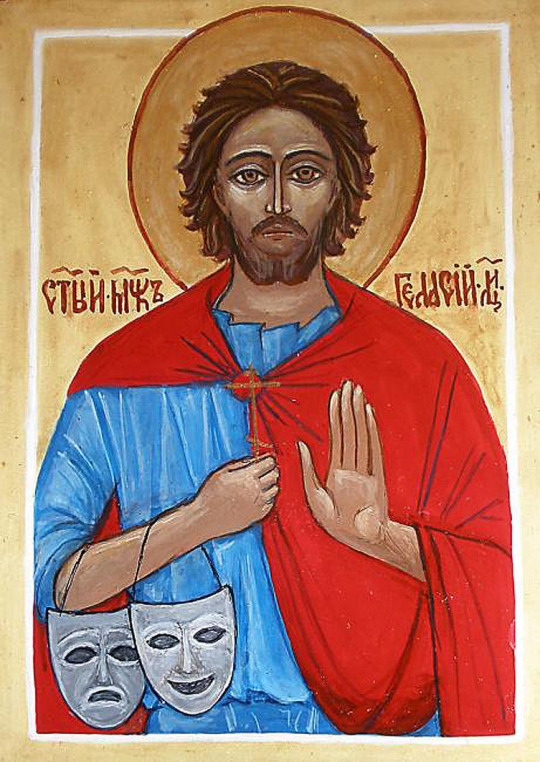
The Holy Martyr Ardalion accepted death for Christ under the emperor Maximian Galerius (305-311). Saint Ardalion was a talented mimic actor. One time at the circus he played the rolй of a christian. The actor, on the intent of the play-author, was to at first refuse to offer sacrifice to idols, but later to consent to renounce Christ. Along the course of the action they suspended him upon a wooden torture device and tore at him with iron hooks. He so naturally depicted the suffering, that the spectators were delighted and loudly declared their praise of his artistry. Suddenly the saint ordered all to be quiet and declared, that he actually was a Christian and did not renounce the Lord. The governor of the city tried to explain the matter thus, that Saint Ardalion was continuing to play the rolй, and at the end of the show he would renounce Christ and offer sacrifice to the gods. But Saint Ardalion continued to confess his faith in Christ. Then the governor gave orders to throw the martyr onto a red-hot iron-pan. Thus did Saint Ardalion merit a martyr's crown.
all texts© 1996-2001 by translator Fr. S. Janos.
ICON:The Vilensk Icon of the Mother of God

The Vilensk Icon of the Mother of God was written by the holy Evangelist Luke. For a long time it was in the family of the Greek emperors at Constantinople. In 1472 Sophia Paleologa, spouse of the Moscow GreatPrince Ivan III (1462-1505), transferred the icon to Moscow. In 1495 the GreatPrince blessed his daughter Elena with this icon before giving her in marriage to the Lithuanian king Alexander. In honour of the transfer of the icon to Vilna a feast was established 15 February. Later on they placed the holy icon in the John the ForeRunner church, in which princess Elena was buried. And afterwards they transferred the icon to the Vilensk Holy-Trinity monastery.
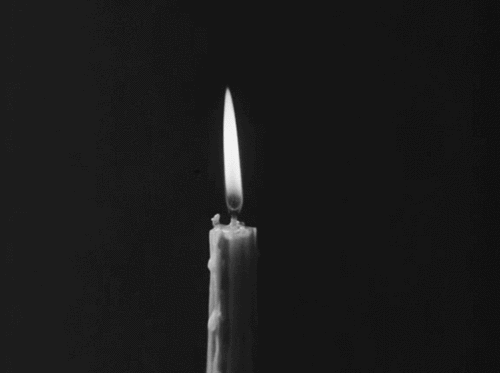
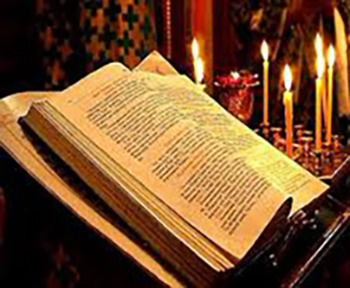
Matthew 24:36-26:2
36 But of that day and hour no one knows, not even the angels of heaven, but My Father only. 37 But as the days of Noah were, so also will the coming of the Son of Man be. 38 For as in the days before the flood, they were eating and drinking, marrying and giving in marriage, until the day that Noah entered the ark, 39 and did not know until the flood came and took them all away, so also will the coming of the Son of Man be. 40 Then two men will be in the field: one will be taken and the other left. 41 Two women will be grinding at the mill: one will be taken and the other left. 42 Watch therefore, for you do not know what hour your Lord is coming. 43 But know this, that if the master of the house had known what hour the thief would come, he would have watched and not allowed his house to be broken into. 44 Therefore you also be ready, for the Son of Man is coming at an hour you do not expect. 45 Who then is a faithful and wise servant, whom his master made ruler over his household, to give them food in due season? 46 Blessed is that servant whom his master, when he comes, will find so doing. 47 Assuredly, I say to you that he will make him ruler over all his goods. 48 But if that evil servant says in his heart, 'My master is delaying his coming,' 49 and begins to beat his fellow servants, and to eat and drink with the drunkards, 50 the master of that servant will come on a day when he is not looking for him and at an hour that he is not aware of, 51 and will cut him in two and appoint him his portion with the hypocrites. There shall be weeping and gnashing of teeth.
1Then the kingdom of heaven shall be likened to ten virgins who took their lamps and went out to meet the bridegroom. 2 Now five of them were wise, and five were foolish. 3 Those who were foolish took their lamps and took no oil with them, 4 but the wise took oil in their vessels with their lamps. 5 But while the bridegroom was delayed, they all slumbered and slept. 6 And at midnight a cry was heard: 'Behold, the bridegroom is coming; go out to meet him!' 7 Then all those virgins arose and trimmed their lamps. 8 And the foolish said to the wise, 'Give us some of your oil, for our lamps are going out.' 9 But the wise answered, saying, 'No, lest there should not be enough for us and you; but go rather to those who sell, and buy for yourselves.' 10 And while they went to buy, the bridegroom came, and those who were ready went in with him to the wedding; and the door was shut. 11 Afterward the other virgins came also, saying, 'Lord, Lord, open to us!' 12 But he answered and said, 'Assuredly, I say to you, I do not know you.' 13 Watch therefore, for you know neither the day nor the hour in which the Son of Man is coming. 14 For the kingdom of heaven is like a man traveling to a far country, who called his own servants and delivered his goods to them. 15 And to one he gave five talents, to another two, and to another one, to each according to his own ability; and immediately he went on a journey. 16 Then he who had received the five talents went and traded with them, and made another five talents. 17 And likewise he who had received two gained two more also. 18 But he who had received one went and dug in the ground, and hid his lord's money. 19 After a long time the lord of those servants came and settled accounts with them. 20 So he who had received five talents came and brought five other talents, saying, 'Lord, you delivered to me five talents; look, I have gained five more talents besides them.' 21 His lord said to him, 'Well done, good and faithful servant; you were faithful over a few things, I will make you ruler over many things. Enter into the joy of your lord.' 22 He also who had received two talents came and said, 'Lord, you delivered to me two talents; look, I have gained two more talents besides them.'23 His lord said to him, 'Well done, good and faithful servant; you have been faithful over a few things, I will make you ruler over many things. Enter into the joy of your lord.' 24 Then he who had received the one talent came and said, 'Lord, I knew you to be a hard man, reaping where you have not sown, and gathering where you have not scattered seed. 25 And I was afraid, and went and hid your talent in the ground. Look, there you have what is yours.' 26 But his lord answered and said to him, 'You wicked and lazy servant, you knew that I reap where I have not sown, and gather where I have not scattered seed. 27 'So you ought to have deposited my money with the bankers, and at my coming I would have received back my own with interest. 28 Therefore take the talent from him, and give it to him who has ten talents. 29 'For to everyone who has, more will be given, and he will have abundance; but from him who does not have, even what he has will be taken away. 30 'And cast the unprofitable servant into the outer darkness. There will be weeping and gnashing of teeth.' 31 When the Son of Man comes in His glory, and all the holy angels with Him, then He will sit on the throne of His glory. 32 All the nations will be gathered before Him, and He will separate them one from another, as a shepherd divides his sheep from the goats. 33 And He will set the sheep on His right hand, but the goats on the left. 34 Then the King will say to those on His right hand, 'Come, you blessed of My Father, inherit the kingdom prepared for you from the foundation of the world: 35 'for I was hungry and you gave Me food; I was thirsty and you gave Me drink; I was a stranger and you took Me in; 36 I was naked and you clothed Me; I was sick and you visited Me; I was in prison and you came to Me.' 37 Then the righteous will answer Him, saying, 'Lord, when did we see You hungry and feed You, or thirsty and give You drink? 38 'When did we see You a stranger and take You in, or naked and clothe You? 39 Or when did we see You sick, or in prison, and come to You? 40 And the King will answer and say to them, 'Assuredly, I say to you, inasmuch as you did it to one of the least of these My brethren, you did it to Me.' 41 Then He will also say to those on the left hand, 'Depart from Me, you cursed, into the everlasting fire prepared for the devil and his angels: 42 'for I was hungry and you gave Me no food; I was thirsty and you gave Me no drink; 43 'I was a stranger and you did not take Me in, naked and you did not clothe Me, sick and in prison and you did not visit Me.'44 Then they also will answer Him, saying, 'Lord, when did we see You hungry or thirsty or a stranger or naked or sick or in prison, and did not minister to You?' 45 Then He will answer them, saying, 'Assuredly, I say to you, inasmuch as you did not do it to one of the least of these, you did not do it to Me.' 46 And these will go away into everlasting punishment, but the righteous into eternal life.
1Now it came to pass, when Jesus had finished all these sayings, that He said to His disciples,2 You know that after two days is the Passover, and the Son of Man will be delivered up to be crucified.
#orthodoxy#orthodoxchristianity#ancientchristianity#originofchristianity#spirituality#holyscriptures#gospel#wisdom
6 notes
·
View notes
Text
Saints&Reading: Sat., Apr., 24, 2021
LAZARUS ATURDAY
by Archbishop Andrei (Rymarenko)
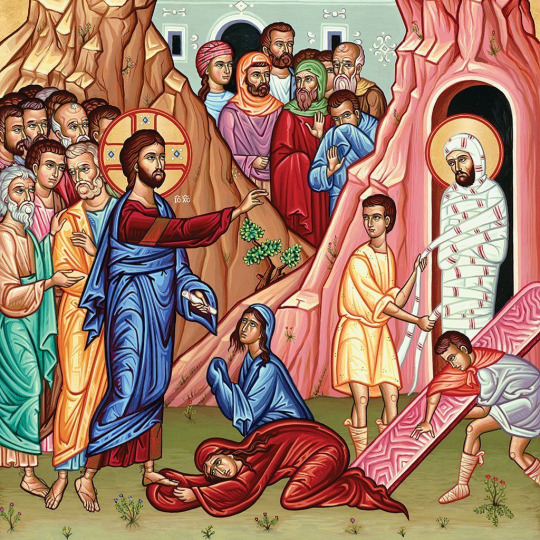
“In the same way we cry to Thee, O Conqueror of death: Hosanna in the highest, blessed is He Who comes in the name of the Lord” (Troparion (hymn) sung on Lazarus Saturday).
Great is this Holy Day, brothers and sisters! Just think of it, “Conqueror of death”! There have been many conquerors in the history of humanity: many gifted doctors have conquered many sicknesses, many military leaders have conquered tremendous armies, even entire countries. There have been conquerors of space such as the inventors of automobiles, airplanes; conquerors of distance — the inventors of the telephone, telegraph, and so on. But “Conqueror of death” — the whole world does not know of anyone else but Jesus Christ. He alone. Even the so-called “unbelieving world” cannot mention another name. No one among the most prominent people would ever even attempt to make such a claim. But He is, was, and will be — our Savior and our Lord.
During His historical evangelistic life He proved this in three instances: the resurrection of the daughter of Jairus, the resurrection of the son of the widow of Nain, and here in today’s Gospel, the resurrection of Lazarus.
The death of the daughter of Jairus was a recent one. She died while Christ and her father were going to her. Even Christ called it slumber; but the people “laughed Him to scorn, knowing that she was dead. And He put them all out, and took her by the hand, and called, saying, Maid, arise! And her spirit came again, and she arose straightway: and He commanded to give her meat” (Lk. 8:53-55).
In the case of the son of the widow of Nain, death, seemingly stronger, came into its own: the dead man had already been laid on the funeral bier. They had carried him not only from the house, but already through the city gates. In order to touch the bier, the Lord had to stop the carriers. And only then did He say, “Young man, I say unto thee, Arise! And he that was dead sat up, and began to speak. And He delivered him to his mother” (Lk. 7:14-15).
And now Lazarus. The victory of death here was final, one hundred percent. Lazarus had been in the tomb four days already. There was weeping, but no one had any hope of an instantaneous resurrection. Even one of the dead man’s sisters said to the Lord: “I know he shall rise again in the resurrection at the last day.” Even the Lord Himself, when He “saw her weeping, and the Jews also weeping which came with her, He groaned in the spirit, and was troubled,” and He wept. Finally He said, “Take ye away the stone.” Here, even the sister of the dead man could not contain herself and said to Him: “Lord, by this time he stinketh: for he hath been dead four days.” So the stone was removed from the tomb where the dead man was lying, and Christ cried with a loud voice, “Lazarus, come forth! And he that was dead came forth bound hand and foot with grave clothes: and his face was bound about with a napkin. Jesus saith unto them, Loose him, and let him go” (Jn. 11:17-44).
Besides physical death, there is mental death. Physical death is visible to everyone, but mental death is usually not noticeable to people. It is felt only by the dead person himself. Bishop Theophan the Recluse said much about this. Sometimes it happens that a sinful thought darts into your mind and awakens a sinful feeling, but the soul catches itself and calls to the Lord in repentance. And the Lord, as with the daughter of Jairus, will as if stretch out His hand and say, “Soul, arise!” And life will return to its joyous flow. But sometimes it happens that we do not catch ourselves in time and sin enters more deeply into our soul (like going out from the house) and the result will be full acceptance of the sin, and turmoil. But also here, by the prayers of our Mother, the Church of Christ, who cries before the Lord for her children, we can be alerted; and the Lord will tell us as He did the son of the widow of Nain: “Soul, I say unto thee, Arise!” This is salvation.
But what shall we do if sin completely enslaves our soul, as if covering it with a tombstone; and so day after day goes by and passions start to exude their sinful stench, just as with Lazarus? What should we do then? Well, then we need confession, the sacrament which Christ established after His Resurrection, when He said to His disciples, “Receive ye the Holy Spirit: Whose so ever sins ye forgive, they are forgiven” (Jn. 20:22-23). See how all this is reflected in the resurrection of Lazarus. Lazarus, on his own, could not go out from the tomb because it was blocked by a stone. He couldn’t even walk, because he was bound hand and foot with funeral bandages. And here Christ said to His disciples, “Loose him.” In application to us, this means that the Lord orders our clergy, who have received in the Sacrament of the Priesthood the gift of the Holy Spirit, to loose our sins. What joy!
And more: death is not the cause but only the result, the consequence of sin. And Christ is, first of all, the Conqueror of sin, and then along with it, the Conqueror of death. So let us triumph: “Hosanna in the highest!”
The Priest Martyr Antipas (92)
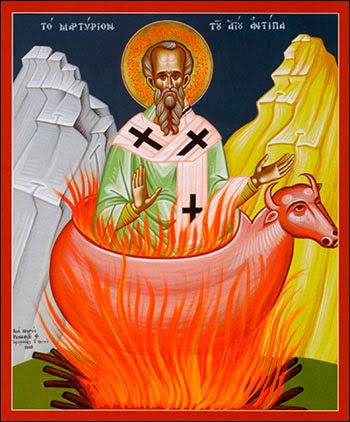
A disciple of the holy Apostle John the Theologian (Comm. 26 September), was bishop of the Church of Pergamum during the reign of the emperor Nero (54-68). During these times by order of the emperor, everyone who would not offer sacrifice to the idols lived under threat of either exile or execution. And then too on the island of Patmos (in the Aegean Sea) was imprisoned the holy Apostle John the Theologian – he to whom the Lord revealed the future judgements of the world and of Holy Church.
��"And to the Angel of the Pergamum Church write: thus sayeth He having the sword sharp of both edges: I do know thine deeds, and that thou dost live there, where doth be the throne of Satan, and that thou dost cleave unto My Name nor didst renounce My faith even in those days, in which My slain faithful witness Antipas was amongst ye, where Satan dwelleth" (Rev. 2: 12-13).
By his personal example, firm faith and constant preaching about Christ, Saint Antipas began to sway the people of Pergamum from offering sacrifice to idols. The pagan priests reproached the bishop for turning the people away from their ancestral gods, and they demanded that he stop preaching about Christ and instead offer sacrifice to the idols. Saint Antipas calmly answered, that he was not about to serve the demon-gods, which flee before him who was but a mortal man; rather, it is the Lord Almighty that he worships and would continue to worship – the Creator of all, together with His Only‑Begotten and One-in-Essence Son and Holy Spirit. The pagan priests retorted, that their gods existed from of old, whereas Christ was not from of old and was crucified under Pontius Pilate as a criminal. The saint answered, that the pagan gods were the work of human hands and that everything said about them was filled with iniquities and vices. He steadfastly confessed his faith in the Son of God, incarnated of the MostHoly Virgin. The enraged pagan priests dragged the PriestMartyr Antipas to the temple of Artemis and threw him into a red-hot copper bullock, wherein usually they cast the sacrifices to the idols. In the red-hot furnace the priest-martyr prayed loudly to God, imploring to accept his soul and to fortify Christians in the faith. He expired to the Lord peacefully, as though asleep (+ c. 68). Christians by night took the body of the PriestMartyr Antipas, untouched by the fire, and with reverence they buried him at Pergamum. The tomb of the priest-martyr became a font of miracles and of healings from manifold sicknesses. Particular recourse to the PriestMartyr Antipas is made during times of tooth-ache.
All translation©1996-2001 by translator Fr. S. Janos.
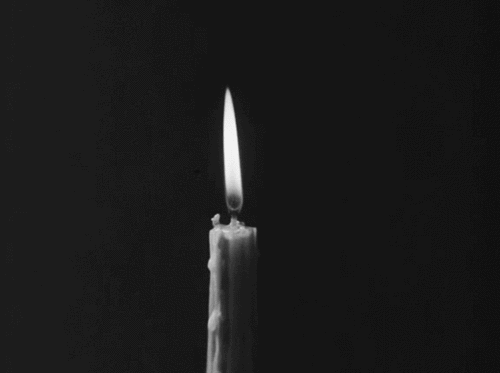
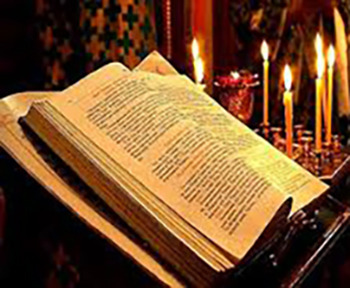
John 11:1-45
1 Now a certain man was sick, Lazarus of Bethany, the town of Mary and her sister Martha. 2 It was that Mary who anointed the Lord with fragrant oil and wiped His feet with her hair, whose brother Lazarus was sick. 3 Therefore the sisters sent to Him, saying, "Lord, behold, he whom You love is sick." 4 When Jesus heard that, He said, "This sickness is not unto death, but for the glory of God, that the Son of God may be glorified through it." 5 Now Jesus loved Martha and her sister and Lazarus. 6 So, when He heard that he was sick, He stayed two more days in the place where He was. 7 Then after this He said to the disciples, "Let us go to Judea again." 8 The disciples said to Him, "Rabbi, lately the Jews sought to stone You, and are You going there again?" 9 Jesus answered, "Are there not twelve hours in the day? If anyone walks in the day, he does not stumble, because he sees the light of this world. 10 But if one walks in the night, he stumbles, because the light is not in him. 11 These things He said, and after that He said to them, "Our friend Lazarus sleeps, but I go that I may wake him up." 12 Then His disciples said, "Lord, if he sleeps he will get well." 13 However, Jesus spoke of his death, but they thought that He was speaking about taking rest in sleep.14 Then Jesus said to them plainly, "Lazarus is dead. 15 And I am glad for your sakes that I was not there, that you may believe. Nevertheless let us go to him. 16 Then Thomas, who is called the Twin, said to his fellow disciples, "Let us also go, that we may die with Him." 17 So when Jesus came, He found that he had already been in the tomb four days. 18 Now Bethany was near Jerusalem, about two miles away. 19 And many of the Jews had joined the women around Martha and Mary, to comfort them concerning their brother. 20 Then Martha, as soon as she heard that Jesus was coming, went and met Him, but Mary was sitting in the house. 21 Now Martha said to Jesus, "Lord, if You had been here, my brother would not have died. 22 But even now I know that whatever You ask of God, God will give You. 23 Jesus said to her, "Your brother will rise again."24 Martha said to Him, "I know that he will rise again in the resurrection at the last day."25 Jesus said to her, "I am the resurrection and the life. He who believes in Me, though he may die, he shall live.26 And whoever lives and believes in Me shall never die. Do you believe this? 27 She said to Him, "Yes, Lord, I believe that You are the Christ, the Son of God, who is to come into the world." 28 And when she had said these things, she went her way and secretly called Mary her sister, saying, "The Teacher has come and is calling for you." 29 As soon as she heard that, she arose quickly and came to Him. 30 Now Jesus had not yet come into the town, but was in the place where Martha met Him. 31 Then the Jews who were with her in the house, and comforting her, when they saw that Mary rose up quickly and went out, followed her, saying, "She is going to the tomb to weep there." 32 Then, when Mary came where Jesus was, and saw Him, she fell down at His feet, saying to Him, "Lord, if You had been here, my brother would not have died." 33 Therefore, when Jesus saw her weeping, and the Jews who came with her weeping, He groaned in the spirit and was troubled. 34 And He said, "Where have you laid him?" They said to Him, "Lord, come and see."35 Jesus wept.36 Then the Jews said, "See how He loved him!" 37 And some of them said, "Could not this Man, who opened the eyes of the blind, also have kept this man from dying?" 38 Then Jesus, again groaning in Himself, came to the tomb. It was a cave, and a stone lay against it. 39 Jesus said, "Take away the stone." Martha, the sister of him who was dead, said to Him, "Lord, by this time there is a stench, for he has been dead four days." 40 Jesus said to her, "Did I not say to you that if you would believe you would see the glory of God?" 41 Then they took away the stone from the place where the dead man was lying. And Jesus lifted up His eyes and said, "Father, I thank You that You have heard Me. 42 And I know that You always hear Me, but because of the people who are standing by I said this, that they may believe that You sent Me.43 Now when He had said these things, He cried with a loud voice, "Lazarus, come forth!"44 And he who had died came out bound hand and foot with graveclothes, and his face was wrapped with a cloth. Jesus said to them, "Loose him, and let him go."45Then many of the Jews who had come to Mary, and had seen the things Jesus did, believed in Him.
Hebrews 12:28-13:8
28 Therefore, since we are receiving a kingdom which cannot be shaken, let us have grace, by which we may serve God acceptably with reverence and godly fear. 29 For our God is a consuming fire.
1 Let brotherly love continue. 2 Do not forget to entertain strangers, for by so doing some have unwittingly entertained angels. 3 Remember the prisoners as if chained with them-those who are mistreated-since you yourselves are in the body also. 4 Marriage is honorable among all, and the bed undefiled; but fornicators and adulterers God will judge. 5 Let your conduct be without covetousness; be content with such things as you have. For He Himself has said, "I will never leave you nor forsake you." 6 So we may boldly say: "The LORD is my helper; I will not fear. What can man do to me?" 7 Remember those who rule over you, who have spoken the word of God to you, whose faith follow, considering the outcome of their conduct. 8 Jesus Christ is the same yesterday, today, and forever.
5 notes
·
View notes